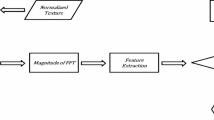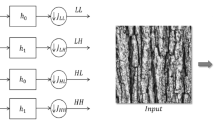Abstract
In aims to ensure images authentication, this paper proposes a blind spatial domain-based image watermarking using texture analysis and association rules mining. The idea is to identify the strongly textured locations in the host image for inserting the watermark. Indeed, texture is correlated with the Human Visual System (HVS). It can therefore be helpful in designing a watermarking approach to enhance the imperceptibility and the robustness. Here a solution is proposed in which four gray-scale histogram based-image features (DC, skewness, kurtosis, and entropy) are chosen as input data for designing association rules. Subsequently, the Apriori algorithm is applied to mine the relationships between the selected features. The higher significant relationships between the selected features are used to identify the strongly textured blocks for watermark embedding. Two strong parameters (lift and confidence) computed using association rules mining were used to design a means of blind watermarking. The experimental results show that interesting ratios of imperceptibility, robustness and embedding rate with low execution time can be obtained by this approach.











Similar content being viewed by others
References
Abdelhakim A, Saleh H, Nassar A (2017) A quality guaranteed robust image watermarking optimization with artificial bee Colony. Expert Syst Appl 72:317–326
Aggarwal C, Han J (2014) Frequent pattern mining. Springer International Publishing, Switzerland
Agrawal R, Imielinski T, Swami A (1993) Database mining: a performance perspective. IEEE Trans Knowl Data Eng 5(6):914–925
Ben-Messaoud R, Boussaid O, Rabaseda S (2006) Mining association rules in OLAP cubes. IEEE Conf Innov Inform Technol::1–5
Bouslimi D, Coatrieux G, Cozic M, Roux C (2012) A joint encryption/watermarking system for verifying the reliability of medical images. IEEE Trans Inf Technol Biomed 16(5):891–899
Cox I, Miller M, Bloom J (2000) Watermarking applications and their properties. Proc Int Conf Inform Technol: Coding Comput-ITCC::6–10
Das A (2015) Guide to signals and patterns in image processing: foundations, methods and applications. Springer International Publishing, Switzerland
Das C, Panigrahi S, Sharma V, Mahapatra K (2014) A novel blind robust image watermarking in DCT domain using inter-block coefficient correlation. AEU-Int J Electron Commun 68(3):244–253
Djenouri Y, Comuzzi M (2017) Combining Apriori heuristic and bio-inspired algorithms for solving the frequent itemsets mining problem. Inf Sci 420:1–15
Dubey K, Mushrif M, Mitra K (2016) Segmentation of brain MR images using rough set based intuitionistic fuzzy clustering. Biocybernet Biomed Eng 36(2):413–426
Findik O, Babaoğlu İ, Ülker E (2011) Implementation of BCH coding on artificial neural network-based color image watermarking. Int J Innov Comput Inf Control 7(8):4905–4914
Ghadi M, Laouamer L, Moulahi T (2016) Securing data exchange in wireless multimedia sensor networks: perspectives and challenges. Multimed Tools Appl 75(6):3425–3451
Ghadi M, Laouamer L, Nana L, Pascu A (2016) A novel zero-watermarking approach of medical images based on Jacobian matrix model. Sec Comm Netw 9(18):5203–5218
Ghadi M, Laouamer L, Nana L, Pascu A (2016) A robust associative watermarking technique based on frequent pattern mining and texture analysis. Proc 8th Int ACM Conf Manag Comput Collect Intell Digit Ecosyst ACM:73–81
Ghadi M, Laouamer L, Nana L, Pascu A (2017) A robust watermarking technique in spatial domain using closeness coefficients of texture. Proc 8th Int Conf Inform Intell Syst Appl:1–6
Haddada L, Dorizzi B, Ben-Amara N (2017) A combined watermarking approach for securing biometric data. Signal Process Image Commun 55:23–31
Hahsler M, Chellubonia S (2015) Visualizing association rules: introduction to the R-extension package a rules Viz. Project module. Technical report, Southern Methodist University
Han J, Zhao X, Qiu C (2016) A digital image watermarking method based on host image analysis and genetic algorithm. J Ambient Intell Human Comput 7:37–45
Hsu L-Y, Hu H-T (2015) Blind image watermarking via exploitation of inter-block prediction and visibility threshold in DCT domain. J Vis Commun Image Represent 32:130–143
Hsu L-Y, Hu H-T (2017) Robust blind image watermarking using crisscross inter-block prediction in the DCT domain. J Vis Commun Image R 46:33–47
Hu H-T, Hsu L-Y (2016) A mixed modulation scheme for blind image watermarking. Int J Electron Commun (AEÜ) 70:172–178
Jovanoski V, Lavra N (2001) Classification rule learning with APRIORI-C. in proceedings of 10th Portuguese conference on artificial intelligence knowledge extraction, Multi-agent Systems, Logic Programming, and Constraint Solving, Springer 2258:44–51
Kalra G, Talwar R, Sadawarti H (2015) Adaptive digital image watermarking for color images in frequency domain. Multimed Tools Appl 74(17):6849–6869
Khalili M (2015) DCT-Arnold chaotic based watermarking using JPEG-YCbCr. Optik-Int J Light Electron Optics 126:4367–4371
Korn F, Labrinidis A, Kotidis Y, Faloutsos C (1998) Ratio rules: a new paradigm for fast, quantifiable data mining. Proc 24th VLDB Conf New York, USA
Kumar S, Jaina N, Fernandes S (2017) Rough set based effective technique of image watermarking. J Comput Sci 19:121–137
Maggi F, Ciccio C, Francescomarino C, Kala T (2018) Parallel algorithms for the automated discovery of declarative process models. Inf Syst 74(2):136–152
Materka A, Strzelecki M (1998) Texture analysis methods-a review. Technical university of Lodz, institute of electronics, COST B11 Report, Brussels: 9–11
Moosazadeh M, Ekbatanifard G (2017) An improved robust image watermarking method using DCT and YCoCg-R color space. Optik 140:975–988
Nikolaidis A, Pitas I (2003) Asymptotically optimal detection for additive watermarking in the DCT and DWT domains. IEEE Trans Image Process 12(5):363–571
Parah S, Sheikh J, Loan N, Bhat G (2016) Robust and blind watermarking technique in DCT domain using inter-block coefficient differencing. Digit Sign Process 53:11–24
Petitcolas F, Anderson R, Kuhn M (1998) Attacks on copyright marking systems. Proceedings of 2nd workshop on information hiding. Lecture Notes Comput Sci Springer 1525:218–238
Sirkaya-Turk E, Uysal M, Hammit W, Vaske J (2011) Research methods for leisure, recreation, and tourism. Prentice Hall, United States
Su Q, Chen B (2017) Robust color image watermarking technique in the spatial domain. Soft Comput:1–16
Sudhir R (2015) A survey on image mining techniques: theory and applications. Int J Comput Eng Intell Syst 2(6):44–52
Tan P-N, Steinbach M, Kumar V (2006) Introduction to data mining. Pearson Inc, USA
Taniar D (2008) Data mining and knowledge discovery technologies. IGI Global, USA
Thanki R, Borra S, Dwivedi V, Borisagar K (2017) An efficient medical image watermarking scheme based on FDCuT–DCT. Eng Sci Technol Int J 20:1366–1379
Umbaugh S (2011) Digital image processing and analysis: human and computer vision applications with CIVP tools. J Electron Imag 20(3):335–399
Wang X, Liu C (2017) A novel and effective image encryption algorithm based on chaos and DNA encoding. Multimed Tools Appl 76(5):6229–6245
Wang Y, Pearmain A (2004) Blind image data hiding based on self reference. Pattern Recog Lett 25:1681–1689
Wang Z, Bovik A, Sheikh H (2005) Structural similarity based image quality assessment. Digital video image quality and perceptual coding (signal processing and communications) book. CRC Press, USA
Yamac M, Dikici Ç, Sankur B (2016) Hiding data in compressive sensed measurements: a conditionally reversible data hiding scheme for compressively sensed measurements. Digit Sign Process 48:188–200
Yang H, Yin J (2013) A secure removable visible watermarking for BTC compressed images. Multimed Tools Appl 74(6):1725–1739
Zaidan B, Zaidan A, Abdul-Karim H, Ahmad N (2016) A new digital watermarking evaluation and benchmarking methodology using an external group of evaluators and multi-criteria analysis based on large-scale data. Software: practice and experience. Softw Pract Exper 47(10):1365–1392
Zebbiche K, Khelifi F, Loukhaoukha K (2018) Robust additive watermarking in the DTCWT domain based on perceptual masking. Multimed Tools Appl 77(16):21281–21304
Zhang Y, Jiang J, Zha Y, Zhang H, Zhao S (2013) Research on embedding capacity and efficiency of information hiding based on digital images. Int J Intell Sci 3:77–85
Author information
Authors and Affiliations
Corresponding author
Additional information
Publisher’s Note
Springer Nature remains neutral with regard to jurisdictional claims in published maps and institutional affiliations.
Rights and permissions
About this article
Cite this article
Ghadi, M., Laouamer, L., Nana, L. et al. A blind spatial domain-based image watermarking using texture analysis and association rules mining. Multimed Tools Appl 78, 15705–15750 (2019). https://doi.org/10.1007/s11042-018-6851-2
Received:
Revised:
Accepted:
Published:
Issue Date:
DOI: https://doi.org/10.1007/s11042-018-6851-2




